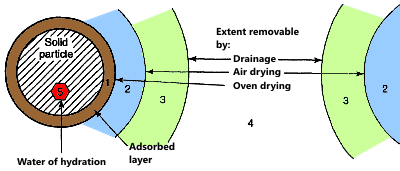1. Definition:
Soil moisture content (or water content) is the amount of water which can be removed when a soil sample is dried at the temperature of 105°C. Moisture content is usually expressed as a percentage of the dry mass.
Remarks:
a) Soil samples should not be heated over 60°C (according to standard TCVN) or 80°C (according to standard ASTM) if they contains gypsum or organic material.
b) Soil samples are required to have special treatments before conducting the moisture content test if they contain saline water.
Water in soil samples distributes in different layers:
|
|
| (Source: Manual of Soil Laboratory Testing, Vol. 1, K.H. Head) |
| Layer 1 | this layer cannot be removed by oven drying at the temperature of 105°C | |
| Layer 2 | this layer cannot be removed by air drying except for oven drying at the temperature of 105°C | |
| Layer 3 | this layer is held by the surface tension, could be removed by air drying (the equivalent temperature of 60°C) | |
| Layer 4 | free water in pores or voids among soil grains | |
| Layer 5 | this layer is inside the crystal structures of soil particles. This water could not be removed by oven drying at the temperature of 105°C (except for gypsum or some tropical clays). |
In general, if soil samples are heated up to 105°C, layers 2, 3 and 4 but not layer 1 will be removed.
2. Calculation:
![]()
where :
| W | moisture content (%) |
| mw | water mass of soil sample (g) Mass of water is determined by the difference in mass of the soil sample before and after oven drying at 105°C |
| md | dry soil mass (g) |
3. Method:
In order to carry out the moisture content test, one should refer to following standards:
a) ASTM D2216 : Standard Test Method for Determination of Water (Moisture) Content of Soil and Rock by Mass
b) ASTM D4643 : Standard Test Method for Determination of Water (Moisture) Content of Soil by the Microwave Oven Heating
c) ASTM D4944 : Standard Test Method for Field Determination of Water (Moisture) Content of Soil by the Calcium Carbide Gas Pressure Tester Method
d) ASTM D4959 : Standard Test Method for Determination of Water (Moisture) Content of Soil By Direct Heating
e) K.H. Head (2006). Manual of Soil Laboratory Testing, Volume 1: Soil Classification and Compaction Tests. Whittles Publishing
4. Data uncertainty:
According to ASTM D2216, a coefficient of variation of moisture contents is 2.7% or 5.0%, respectively, due to the performance of the same operator or multi-laboratories.
Therefore, results of two properly conducted tests should not be considered as outliers if their difference is not beyond the limit in the following table:
| Testing condition | Maximum limit of the difference between two values of moisture content (from their mean value) |
|
| ASTM D2216 | TCVN 4196 | |
| Single-operator | 7.8% | 10% |
| Multi-laboratories | 14% | ? |














